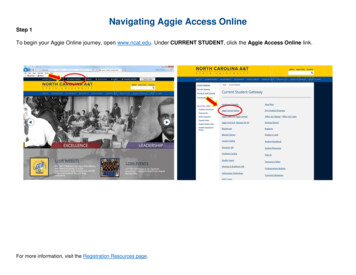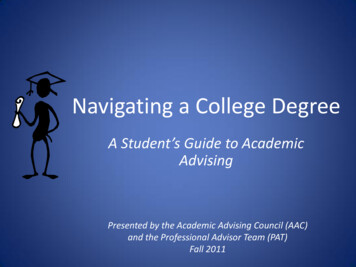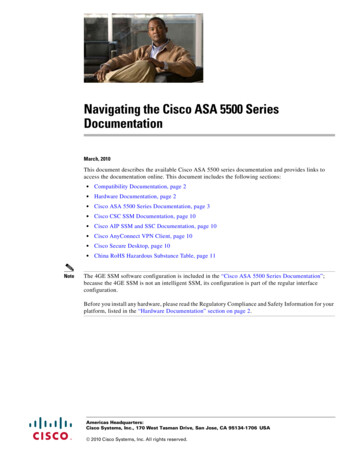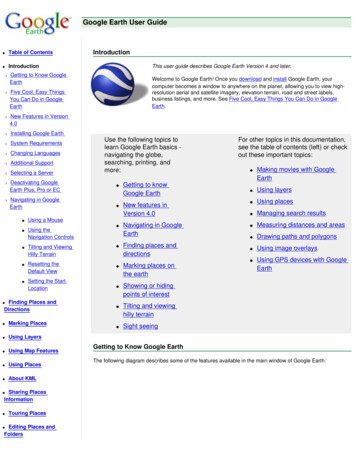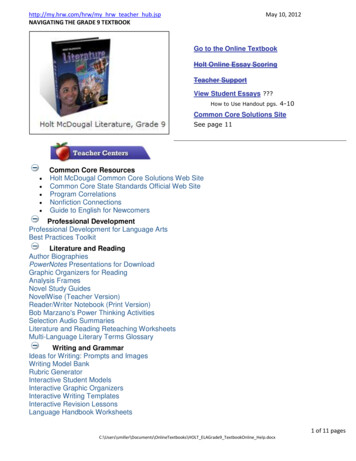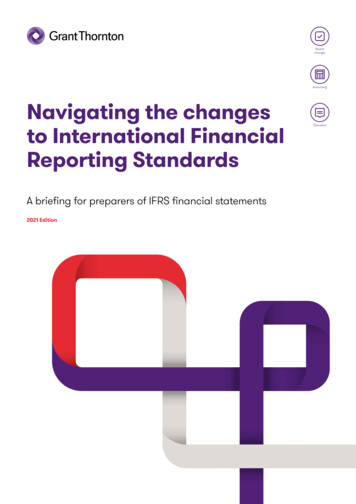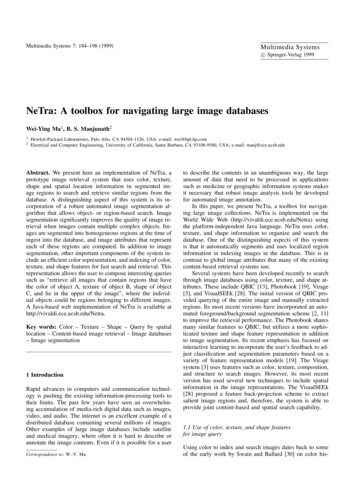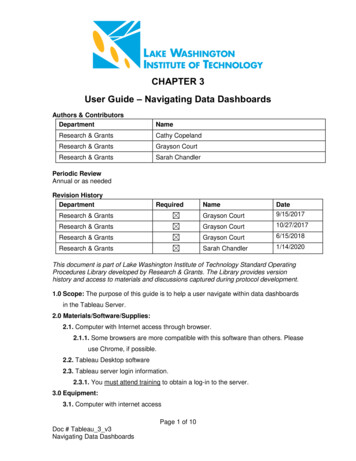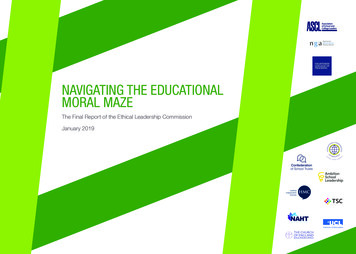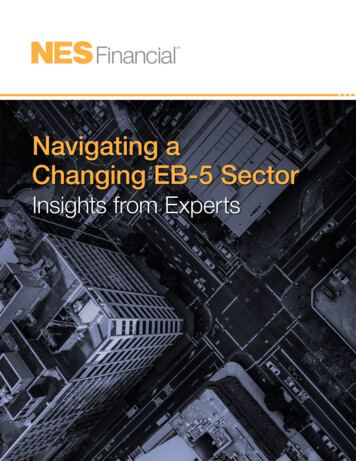
Transcription
Navigating aChanging EB-5 SectorInsights from Experts
IntroductionAt NES Financial, we are fortunate to have the unique opportunity to work with many of the leading experts acrossthe EB-5 ecosystem. Based on our experience in the sector, we have learned that one of the most importantfactors to a successful EB-5 project is to work with the right team. Our Medallion Partner Program recognizesfirms that we believe embrace our vision of best practices and that we are comfortable recommending.We are delighted to have the opportunity to share this, our first ever NES Financial eBook, Navigating a ChangingEB-5 Sector: Insights from Experts. This eBook includes articles on a variety of pertinent industry topics with awide range of perspectives from some of our Medallion Partners, including leading immigration attorneys, securitiesattorneys, economists, and business plan writers.Articles touch on many of the current hot topics in the EB-5 industry. Our hope is that you will find the informationcontained here to be interesting, and if the opportunity presents itself, you will consider one of our MedallionPartners for your project.This is the first of many eBooks that you can expect from us in the future covering current topics and trends as theEB-5 program continues to evolve.Sincerely,Reid ThomasNES Financial Executive Vice Presidentwww.nesfinancial.comIntroduction
ContentsWoo Hoo! The JOBS Act Means No More Securities Compliance in EB-5, Right? Not So Fast.By: Michael G. Homeier, Esq.The Emergence of Rule 506(c)By: Jor Law, Esq.The Overlooked Role of the USCIS in EB-5’s FutureBy: Joseph McCarthyThe Impact of High Volatility Commercial Real Estate Rules on EB-5 InvestmentsBy: Mark A. Katzoff, Arren Goldman, and Gregory L. WhiteThe Importance of the EB-5 Business PlanBy: Phil CohenThe Importance of Having a Single Quarterback in Your EB-5 ProcessBy: Lauren Cohen“Evolving Role of EB-5 Counsel” – Considerations for Multi-Party Representation in EB-5 DealsBy: Nima Korpivaara, Esq. and Phuong Le, Esq.Is the EB-5 Regional Center “Pure” Rental Model Sustainable?By: Rohit KapuriaAn Explanation of the EB-5 Immigrant Visa Backlog for Chinese EB-5 Investors – How Did We Get Here?By: Bernard P. Wolfsdorf, Esq., Joseph M. Barnett, Esq., and Robert J. Blanco, Esq.Suggested Procedures and Possible Options for Accepting Minors as Investors in EB-5 Investment FundsBy: Catherine DeBono Holmes, Esq. and Bernard P. Wolfsdorf, Esq.EB-5 Risk Management and Insurance Facts: A Discussion about EB-5 Risk Exposures and Related Risk Management ToolsBy: Bonnie Novella, CAIASearching for a Silver Lining in VermontBy: H. Ronald Klasko and Tammy Fox-IsicoffIs the EB-5 Bubble Ready to Burst?By: Kaitlin 2Table of Contents
Woo Hoo! The JOBS Act MeansNo More Securities Compliancein EB-5, Right? Not So Fast.By: Michael G. Homeier, Esq.2012’s Jumpstart Our Business Startups (JOBS) Act was hailed in the EB-5 industry as meaning that the expensive,time-consuming, and complicated compliance with U.S. securities laws was now history. But while the JOBS Actremoved some impediments to selling EB-5 investments, it did not eliminate the application of U.S. securitieslaws to EB-5.Securities Law Marketing LimitationsAn investment opportunity managed by someone(s) other than the investor generally constitutes a “security.” Toprotect investors, offers and sales of securities are regulated by federal and state securities laws.Those laws require that all securities offerings be registered with the government through a complex, lengthy, andexpensive process, unless the offering is exempt. The two primary exemptions are Regulation D (“Reg D”), the“private offering exemption,” and Regulation S (“Reg S”), for “exclusively overseas offerings.”Regulation D exempts private offerings not offered to the public. Private offerings cannot market securities using“general solicitation or advertising,” defined as any advertisement, article, notice, or other communication publishedin any newspaper, magazine, or similar media, or broadcast over television or radio (or the internet). (Reg S is similar.)This significantly hamstrings the marketing of offerings. Most companies lack exposure to potential investors andrely on introductions by others, such as brokers. With increasing numbers of competing investments, EB-5 issuerschafed at taking convoluted steps to find investors, while reining in over-eager (and expensive) brokers who mightimproperly advertise publicly overseas. It is easy to “over-market” and inadvertently turn an exempt private offeringinto an un-exempt (and unlawful) public one.EB-5 and the JOBS Act — or ActsEnter the JOBS Act, a set of six laws, styled Titles I through VI, combining a series of different proposals addressingthe same broad theme of easing restrictions on small business capital raising. EB-5 issuers pay the most attentionwww.nesfinancial.comWoo Hoo! The JOBS Act Means No More Securities Compliance, Right? Not So Fast.1
to the revision of Reg D contained in Title II that markedly eases the fundraising process; however, two more of thesix Titles have an EB-5 impact also.A. Title II, the Access to Capital for Job Creators Act, eliminates the Reg D prohibition on general advertising,including the internet. This change greatly facilitates the offering and solicitation process.To lawfully advertise under Reg D, (1) all investors must in fact be accredited, and (2) issuers must take reasonablesteps to verify accredited investor status. Previously, accredited investors self-certified their status; now called Rule506(b) of Reg D, this may still be done if no public advertising is used. But if the EB-5 issuer uses public advertising, it must claim exemption under Rule 506(c), which requires verification of accredited investor status by independent investigation. More projects are using the Rule 506(c) exemption and the vastly increased marketing it allows.B. Title IV, the Small Company Capital Formation Act, increases offerings under Regulation A. Reg A is not a private placement as are Reg D offerings, rather it is a mini-registration, requiring the filing and approval of an offeringstatement by the SEC, delivery of an offering circular to prospective investors, and filing of periodic reportsafterwards.Reg A provided a simpler, less expensive process than full registration but was capped at 5M. Title IV increasesthe Reg A (now called Regulation A ) ceiling to either 20M or 50M in a 12-month period, with no restrictions onpublic advertising. Both unaccredited and accredited investors may participate.The Reg A issuer is a registered company (although not a public issuer) and, beyond its initial filing obligations, hascontinuing filing obligations, including financial statements and periodic disclosures.With the offering ceiling raised to 50M, EB-5 issuers may opt for the revised Reg A mini-registration either aloneor with a companion Reg D (b) or (c) offering. The Investment Company Act of 1940 limits EB-5 Reg D offeringsusing a two-entity structure to a maximum of 100 investors ( 50M). A Reg A companion offering to a Reg D allowsraising another 50M, including, from unaccredited investors, carrying SEC “pre-approval,” which can alleviateinvestor concern and improve marketability.C. Title III, the Entrepreneur Access to Capital Act, is the “crowdfunding” rule allowing for pooling money raised insmall amounts from large numbers of individuals via the internet. Title III allows raising up to 1M every 12 months(either 2,000 per investor or a percentage of income or worth, up to 100,000). Issuers must meet conditions,including filing and updating information, and advertising is restricted.Crowdfunding offerings require upfront and ongoing disclosures and fees to funding portals and brokers, while fiduciary and other legal duties continue to be owed by issuers to a literal crowd of investors. For EB-5, the low ceiling(capped at 1M) leaves Title III as supplementary financing for small direct EB-5 funding projects.Bottom Line: The Securities Laws Have NOT Gone AwayFor EB-5, the JOBS Act provides significant, immediate easing of certain troublesome securities obligations, mostnotably the Reg D proscription of public advertising and the Reg A ceiling and exclusion of unaccredited investors.It made crowdfunding a real albeit small-scale option for smaller EB-5 projects.www.nesfinancial.comWoo Hoo! The JOBS Act Means No More Securities Compliance, Right? Not So Fast.2
The changes reflect a continuing securities regulation regime — not an ended one. The securities laws still apply,and their complicated and overlapping requirements create potentially punitive consequences for missteps evenunder the revised rules.Even with expanded marketing, content remains strictly governed by the anti-fraud provisions. So, whatever theEB-5 issuer may now more broadly advertise, must still be accurate. The Reg D and A revisions only facilitatebroader advertising to a larger audience of potential investors — they do not eliminate the obligation to provide fulldisclosure.The JOBS Act is making EB-5 easier and enhancing success. EB-5 issuers should continue to work closely withtheir securities counsel to take advantage of the benefits and options provided under the JOBS Act while maintaining full compliance with the remaining securities obligations.About the AuthorMichael Homeier practices in the area of general business, securities, corporate, transactional, and businessfinancing law (including EB-5 and Crowdfunding). With over 30 years’ experience in the corporate and businesstransactional fields, both as in-house corporate counsel and with private law firms, Michael brings a deep levelof legal knowledge and expertise to the Crowdfunding and EB-5 industries. Michael represents a number ofCrowdfunding platforms and portals and regional centers in the EB-5 program and assists all of them with thestructuring of their projects as well as the negotiation and drafting of business and securities documents relevantto Crowdfunding and EB-5 offering projects, including private placement memoranda (PPMs), investor procurement agreements, limited liability agreements, loan agreements, subscription agreements, investor questionnaires,regional center contracts, plus transactional and corporate documents.About Homeier Law P.C.Homeier Law P.C. is a law firm devoted exclusively to corporate and business transactional law, includingsecurities (public and private, especially EB-5 and Crowdfunding). From offices in Los Angeles and New York City,Homeier Law P.C. represents a broad variety of clients, both domestically and internationally, from established andpublicly-traded companies, to startup businesses and entrepreneurs in a wide range of industries. The firm’s practice includes business finance, secured and unsecured lending, mergers and acquisitions, licensing, private andpublic securities, Crowdfunding, venture capital, new media, technology, e-commerce, and other general transactions. Homeier Law P.C. is a leader in EB-5 and Crowdfunding-related corporate and securities transactions,having represented clients on over 250 private offering projects to date.www.nesfinancial.comWoo Hoo! The JOBS Act Means No More Securities Compliance, Right? Not So Fast.3
The Emergenceof Rule 506(c)By: Jor Law, Esq.Most EB-5 capital raises are securities offerings. In the United States, securities offerings must be registered withthe Securities Exchange Commission (SEC) and possibly the states the offering impacts unless an issuer can claiman exemption from registration. In the EB-5 space, the two most common securities exemptions historically reliedupon are Regulation S (Reg S) and Rule 506(b)1 of Regulation D (Reg D). With the passing of the Jumpstart OurBusiness Startups Act (JOBS Act), however, a new Rule 506(c) of Regulation D was implemented. Rule 506(c) maybe a particularly useful exemption for issuers in the EB-5 space.Reg SReg S exempts offers and sales of securities “that occur outside the United States” from needing to register underfederal law. It does not provide for any state law exemption, so an issuer that relies on Reg S as an exemption stillhas to comply with securities laws affecting registration at the state level. Reg S is popular because, other thanthe fact that investors must be not be “U.S. Persons,” there are almost no other qualifications required of investors.Also, Reg S has no limitation on general solicitation or advertising of the offering. Downsides to Reg S are primarilythat it cannot be used in the U.S. (including any activity which might “condition” the U.S.), U.S. Persons may notinvest, and state laws are not preempted.Rule 506(b)Rule 506(b) was and still remains the most commonly used securities exemption for U.S. offerings. It is no surprisethat it also is widely used in the EB-5 industry. The primary advantage of Rule 506(b) is that state laws for securitiesoffered pursuant to the provisions of Rule 506 are preempted by federal law. In other words, issuers that offer securities under the exemption afforded by Rule 506(b) are also exempt from registration under the various state bluesky laws.2 Additionally, there is no maximum limit on the amount of money that can be raised under a Rule 506(b)offering. Rule 506(b), however, comes with an important drawback: issuers cannot generally solicit or advertise theirofferings and may only approach friends, family, and those who have pre-existing substantive relationships with12Prior to implementation of Title II of the JOBS Act, Rule 506(b) was commonly known as Rule 506.Note, however, that the preemption does not affect all types of securities or all types of person.Additionally, while an issuer may not have to register or qualify the securities under the variousstates’ blue sky laws, it may still be required by some states to pay certain fees and make notice filings.www.nesfinancial.comThe Emergence of Rule 506(c)4
them. In addition, Rule 506(b) offerings generally require that investors be “accredited investors,” a federally-definedterm.3 In EB-5, that generally means investors with high income or net worth.Rule 506(c)Rule 506(c) became effective only on September 23, 2013, and as a result of its young age, hasn’t seen widespread adoption in the EB-5 industry yet. Rule 506(c) retains almost all of the benefits of Rule 506(b) but with twonotable differences. The first is a significant advantage in that general solicitation and advertising of the offering isallowed. The second is a disadvantage in that all investors that end up investing must be verified as accreditedinvestors using federally-prescribed “reasonable steps.” However, that disadvantage is less noticeable in the EB-5industry where most investors can easily demonstrate that they are accredited investors and are already accustomed to providing background information for their immigration petition.While there may still be reasons to conduct simultaneous4 Reg S and Rule 506(c) offerings, issuers can also useonly a Rule 506(c) exemption and still generally solicit overseas. Especially for issuers in those states where there isno equivalent Reg S exemption, Rule 506(c) may be the only practical exemption to use. Rule 506(c) is an extremely useful and powerful tool for issuers conducting EB-5 raises. The emergence of Rule 506(c) in the EB-5 space isinevitable as issuers turn to it to unlock the power it provides.About the AuthorJor Law practices corporate and securities transactional law in Los Angeles and is a founding shareholder ofHomeier Law P.C. and founder of VerifyInvestor.com. Jor is particularly well-known for his unparalleled expertise inalternative finance, including EB-5 finance and crowdfunding, both industries where he is recognized as one of theforemost influential transactional attorneys in the world. Jor is licensed to practice law in California and New York.For three consecutive years, Jor was recognized by Super Lawyers magazine as one of “Southern California’sSuper Lawyers – Rising Stars,” placing him among the top 2.5% of the best up-and-coming attorneys in SouthernCalifornia. Using a completely objective model to evaluate attorneys, Avvo rated Jor as a “Superb” attorney, thehighest available rating offered by Avvo. Jor is frequently sought out as a speaker internationally on the topics ofcapital raising, investing, EB-5 finance, securities, and other corporate matters relevant to attorneys, entrepreneurs,and investors.About VerifyInvestor.comVerifyInvestor.com serves as the resource for accredited investor verifications trusted by those who insist onsafety and reliability. These verifications are required by federal laws for generally solicited Regulation D, Rule 506(c)capital raises. In the EB-5 industry, regional centers, project principals, broker-dealers, migration agents, andimmigrant investors have been relying on VerifyInvestor.com as the compliance solution for their accredited investorverification obligations.Copyright 2016. All Rights Reserved. No legal advice is provided in this article. Please consult your own professional advisors for advice applicable to your particular circumstances.34Up to 35 non-accredited investors may invest in a Rule 506(b) offering, but generally most issuers avoid non-accredited investors as the compliance burden increases.An issuer may simultaneously conduct offerings under Reg D and Reg S, and they will not be integrated if properly conducted.www.nesfinancial.comThe Emergence of Rule 506(c)5
The Overlooked Role of theUSCIS in EB-5’s FutureBy: Joseph McCarthyWith the flurry of proposed legislative reforms introduced and debated at the close of 2015 and the more recentCongressional hearings at the outset of 2016, Congress has been prominently positioned at the center of the EB-5reform spotlight. However, in crucial months leading up to the September 30, 2016 reauthorization of the EB-5 regional center program, the greatest ally to the long term longevity of the program may be the United States Citizenship & Immigration Services (USCIS or “the Service”).Since the introduction of draft bill S.1501, titled the American Job Creation and Investment Promotion Reform Act bySenators Grassley (R-IA) and Leahy (D-VT), Congressional reform of the EB-5 program has drawn most of the publicattention. Long-term program reforms and objectives of the USCIS, the government agency most directly responsible for administering the EB-5 program, have largely been overshadowed, though not absent. In both committeetestimony and public correspondence with Congressional leadership, Department of Homeland Security SecretaryJeh Johnson left no doubt that the USCIS supports robust legislative modifications to improve operational capacityand program integrity. As the midpoint of 2016 approaches, amidst unprecedented EB-5 growth and national attention, the USCIS appears poised to step out of the shadows and proactively introduce targeted, limited EB-5 reformsto address stakeholder and government demands.Shifting Program Priorities in the Modern Era of EB-5: Job Creation to Program IntegrityAfter years of relative obscurity, EB-5 investment sky-rocketed as conventional capital sources remained largely unavailable after the collapse of the financial market in 2008. The rapid acceleration of EB-5 investment presented theUSCIS with an extensive and complex EB-5 caseload involving economics, law, business, finance, securities, andbanking that progressively created a bottleneck due to vague guidance, mounting case volumes, limited staffing, andat times, inconsistent adjudication. To foster job creation, the USCIS in 2012 initiated incremental improvements tostreamline case administration and clarify regulatory interpretations. The Service realigned the EB-5 program into thebroader Immigrant Investor Program (IPO) and relocated its office from the California Service Center to Washington,D.C. In a series of small and large-scale public meetings, the IPO committed substantial time and resources to opena dialogue with EB-5 stakeholders. The stated objective of the dialogue was for the USCIS to enact improvementswww.nesfinancial.comThe Overlooked Role of the USCIS in EB-5’s Future6
that maximized economic productivity, job creation, and increased domestic capital investment without sacrificingprogram security and integrity. An early, well-known byproduct of the new public collaboration is the May 30, 2013Policy Memorandum (PM-602-0083), which attempted to clarify the agency’s policies for adjudicating EB-5 applications and petitions (the “May 2013 Policy Memo”).The USCIS has consistently expanded staff in order to reduce processing times, decrease the existing casebacklog, and improve adjudication performance and predictability. During the April 2016 stakeholder call, theyannounced the Immigrant Investor Program Office employs 126 staff and is on track to have 171 employees bythe end of 2016. However, the expansion of the USCIS’ IPO office is still dwarfed by the explosive growth of EB-5regional centers and immigrant investor visa applicants, whose numbers have increased dramatically since 2008.Further, changes at the IPO were not limited to the staff level. In late 2013, the USCIS announced that the new headof the USCIS Immigrant Investor Program Office would be Nicholas Colucci. Director Colucci previously served asAssociate Director of the Department of Treasury’s Financial Crimes Enforcement Network (FinCEN), Analysis andLiaison Division, and his background served as early evidence of shifting priorities toward national security concerns, fraud prevention, and the financial integrity of EB-5 capital.In February 2016 testimony before the Senate Judiciary Committee, Director Colucci reiterated the Service’scommitment to administer the EB-5 program earnestly through specialized staff devoted solely to the program, thecreation of a Fraud Detection and National Security EB-5 Division (FDNS EB-5), and its increased efforts to regulatea quickly growing regional center program. To accomplish these objectives, the USCIS expanded collaboration withfederal agency partners such as the United States Securities and Exchange Commission (SEC), the U.S. Immigration and Customs Enforcement (ICE), the Federal Bureau of Investigation (FBI), U.S. Department of State, andU.S. Attorney’s Offices. While progress has been made, the USCIS has indicated that work remains and thatCongressional action is required.Is 2016 the Year of the USCIS?Unable to pass EB-5 legislative reform by the end of 2015, Congress instead extended the EB-5 program ‘as-is’through September 2016. With the uncertainty of Congressional reform, the USCIS has taken the initiative to address certain pressing issues. Recently, the USCIS announced its IDEA Community campaign to collect additionalinput on EB-5 regulation/policy changes, specifically seeking comment on:1. Minimum investment amounts, which have remained constant since 1991 but could be increased bythe USCIS.2. The TEA designation process.3. The regional center designation process, including but not limited to the exemplar process and thedesignation of the geographic scope of a regional center.4. Indirect job creation methodologies.Not coincidentally, many of these subjects overlap with key elements of the legislative reforms that were previouslyproposed in Congress. Independent from IDEA community campaign, the USCIS has announced its intention towww.nesfinancial.comThe Overlooked Role of the USCIS in EB-5’s Future7
address program integrity issues by implementing additional reforms:1. Expanding the audit program for regional centers, thereby increasing random EB-5 project site visits.2. Introducing I-829 petitioner interviews which will begin this year. Initial interviews will be conducted virtually,and interviewees may be accompanied by counsel, regional center representatives, and/or regionalcenter counsel.3. Increasing the number of embedded Fraud Detection and National Security EB-5 staff by more than a factorof two and more than tripling the number of overseas verification requests sent to posts in support ofcombatting fraud.4. Removing EB-5 regional centers for failure to comply with EB-5 program requirements (as noted by theincreasing number of regional center terminations).5. Expanding security checks (e.g. the Bank Secrecy Act data collected by FinCEN) to cover regional centerbusinesses and certain executives participating in the EB-5 program, thereby strengthening the overall EB-5vetting process.6. Drafting potential regulatory changes to clarify the eligibility requirements and provide additional tools, to theextent allowed by statute, to strengthen the integrity of the program.7. Working closely with Congress up to the next sunset date for regional center program reauthorization(September 30, 2016). The USCIS will prepare guidance for two potential sunset scenarios. Either theRegional Center program lapses but Congress indicated its intention to reauthorize it, or Congress indicatesits intention to let the regional center program lapse permanently.Most recently, the USCIS published a notice of proposed rulemaking in the Federal Register inviting public comment on the proposed U.S. Citizenship and Immigration Services Fee Schedule. The USCIS explained that it hadconducted a comprehensive fee review after refining its cost accounting process and determined that current feesdo not recover the full costs of the services it provides. Adjustments to the fee schedule as it applies to the EB-5program are summarized as follows:1. A New Form I-924A (to be titled “Annual Certification of Regional Center”); Fee: 3,035.2. Form I-924 application for regional center designation or amendment; Fee increases from 6,230 to 17,795.3. Form I-526 immigrant petition; Fee increases from 1,500 to 3,675.4. Form I-829 petition to remove conditions; Fee: 3,750.The USCIS has invited public comment through July 5, 2016 in order to collect data and assess the economic impact the new fees would have on regional centers, but the overall increases in fees would presumably better fundthe Service to implement integrity measures and avoid program controversy.ConclusionThe USCIS has again resumed the mantle of program change proponent. The motivation for action likely stems inpart to a combination of legislative stalemates, public censure, and critical Government Accountability Office andpolicy think-tanks reports; though it would hardly be fair to characterize the impetus for USCIS-led reform as novelor strictly external. What is less clear, however, is how much can be done and how soon. The sunset of the EB-5www.nesfinancial.comThe Overlooked Role of the USCIS in EB-5’s Future8
regional center program is again looming, and because of recent headlines highlighting more alleged large-scalefraud in the program, the chorus of ‘no reauthorization without reform’ is the loudest it has ever been. And unlikelast year, much of Congress’ attention will likely be impacted by the current presidential election.Nevertheless, the USCIS appears poised to selectively address the more limited reforms within its authority. Whilethese reforms may fall short of the objectives sought in the sweeping legislation introduced in 2015, these changes will further broaden integrity and transparency objectives. More importantly, these changes may be crucial tomoving the EB-5 program in the direction necessary to give stakeholders, overseas investors, and elected leadersgreater confidence in the future of EB-5.About the AuthorJoseph McCarthy is a founding partner of McCarthy Nehring PS and American Dream Fund, an operator ofmultiple EB-5 Regional Centers nationwide. McCarthy’s primary area of legal expertise is immigration law, includingall facets of EB-5 immigration. Through his involvement in EB-5, he has been involved in EB-5 capital deploymentof greater than 800 million in job-creating enterprises. In his role as an attorney, McCarthy is a member of theAmerican Immigration Lawyers Association (AILA) and served for four years as the Legislative Committee Chair forthe Association to Invest in USA (IIUSA), a national trade association of EB-5 Regional Centers and service providers responsible for leading EB-5 reform in the United States Congress. McCarthy is a widely recognized speakerabout EB-5 immigration law both domestically and in China. He frequently speaks about EB-5 to developers andbusiness professionals, government officials, attorneys, and individuals interested in immigrating through the EB-5program. For his work in EB-5, he was acknowledged by the Los Angeles Business Journal as one of the “Who’sWho in Real Estate,” EB-5 Magazine as a Top 10 EB-5 Attorneys in Specialized Fields, and by NES Financial asa Medallion Program Partner. McCarthy also serves on the Editorial Board for the EB5Investors Magazine andrecently authored multiple chapters of the EB-5 Handbook.About McCarthy NehringMcCarthy Nehring is a Los Angeles and Seattle-based law firm that has represented more than 50 regionalcenters nationwide, including preparing initial applications for regional center designation and preparation of theirproject materials. Although the firm’s primary practice area is EB-5, it also has experience advising clients in theareas of business, including partnership agreements, commercial leases, and intellectual property licenses andagreements, and real estate, including leasing, construction, and debt/equity structure and financing.www.nesfinancial.comThe Overlooked Role of the USCIS in EB-5’s Future9
The Impact of High VolatilityCommercial Real EstateRules on EB-5 InvestmentsBy: Mark A. Katzoff, Arren Goldman, and Gregory L. WhiteNES Financial is saddened by the sudden passing of Gregory White on June 11th. Greg was veryintelligent, extremely warm, and highly respected in his field. Ou
Is the EB-5 Regional Center "Pure" Rental Model Sustainable? By: Rohit Kapuria An Explanation of the EB-5 Immigrant Visa Backlog for Chinese EB-5 Investors - How Did We Get Here? By: Bernard P. Wolfsdorf, Esq., Joseph M. Barnett, Esq., and Robert J. Blanco, Esq. Searching for a Silver Lining in Vermont By: H. Ronald Klasko and Tammy Fox .
